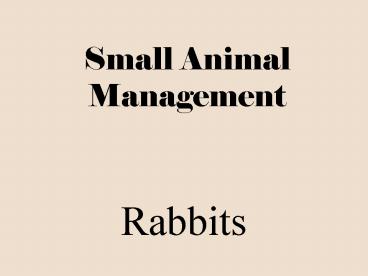Small Animal Management PowerPoint PPT Presentation
1 / 37
Title: Small Animal Management
1
Small Animal Management
- Rabbits
2
I. Terms
- Buck male rabbit
- Doe female rabbit
- Bunny baby rabbit
- Kit baby rabbit
- Kindle giving birth
3
(terms cont.)
- F. Litter group of young kindled by the same
doe - Junior rabbit under 6 months
- Senior rabbit over 6 months
- Breed animals with similar physical
characteristics that are passed on to their
young. - Variety subdivision of a breed, usually by
distinguished by color
4
(terms continued)
- K. Molting shedding fur
- L. Gestation the length of time a female is
pregnant - M. Lactation production of milk
- N. Snuffles respiratory ailment in rabbits
5
II. Parts
6
Neck
Ear
Shoulder
Rump
Cheek
Tail
Dewlap
Belly
Hock
Flank
7
III. Size Classes
- Small
- a. 2 7 lbs
- b. Examples
- 1. Netherland Dwarfs
- 2. Dutch
- 3. Tans
8
(size classes continued)
- Medium
- a. 8 - 12 lbs
- b. Examples
- 1. New Zealands
- 2. Florida Whites
- 3. Satins
9
(size classes continued)
- C. Large
- a. over 13 lbs
- b. Examples
- 1. Flemish Giants
- 2. Checkered Giants
- 3. Giant Lops
10
IV. Classes by Use
- Pets
- Show / Exhibition
- Meat Production
- Pelts
- Wool
- Laboratory / Research
11
V. Breed Selection
- Over 30 recognized breeds
- Over 80 recognized varieties
- (divisions within a breed)
12
(breed selection continued)
- Selection based on use
- 1. Meat Production
- New Zealand (White, Black, Red)
- California (White w/eight black points)
- Satin (Colors vary specialty fur)
13
(breed selection continued)
- (Selection based on use, cont)
- 2. Research
- New Zealand White consistent
- 3. Show / Pet
- Any breed
14
(breed selection continued)
- (Selection based on use, cont)
- 4. Pelts
- Rex
- Mini Rex
- Satin
- 5. Wool
- Angora
15
VI. Locating Breeding Stock
- Feed Stores
- American Rabbit Breeders Association (ARBA)
- Journals / Magazines
16
(Locating Breeding Stock, cont)
- D. Telephone Book
- E. County Agricultural Agent
- F. Agriscience Teacher
- G. County Fair Exhibits
- H. Newspapers
17
VII. Selection of Breeding Stock
- They are healthy and vigorous
- They are average size for their breed
- Age to buy
- Juniors (unproven)
- (-) must wait to breed them
- () can ease them into production
18
(selection of breeding stock/ age to buy
continued)
- 2. Seniors
- (-) age difficult to determine
- () ready for production
- Older Rabbits
- (long heavy toenails and the meat along the back
bone is sinewy (stringy) and tough) - (-) less production potential
- (-) may be sterile
- () may be cheaper
19
(selection of breeding stock continued)
- Start with a trio
- One buck and two does
- Trust the breeder to select compatible breeders
20
VIII. Proper Handling
- Best Method
- Grasp the nap of the neck and the rump
- Always support the hind quarters
- Alternate Methods
- Grasp in front of hip
- Underarm, clutched against body
- C. NEVER BY THE EARS!!!!!
21
IX. Feeding
- Requirements vary depending on
- Weather
- Condition
- Production Stage
- Breed
- Size
- Age
22
(feeding continued)
- Rule of Thumb
- Mature Rabbits - Maintenance
- 3.8 to 4 of their body weight per day
- increases based on growth production
- Easiest buy complete pellets needs
23
(feeding continued)
- D. Limit Feed vs Full Feed (free choice)
- Full Feed gt rabbits eat more cost more
- overweight rabbits lazy/poor breeders
- less attention given to rabbits
24
X. Housing
- Free of Drafts
- Protect from rain, snow, wind, sun heat
- Pens wire floor
- Size 1 square foot floor space per one pound
live rabbit (4 needs 2 ft x 2 ft)
25
XI. Equipment
- Feeders
- Waters
- Nest Boxes
- Tattoo Pliers
26
XII. Reproduction
27
A. Age to breed
- Dwarfs Small breeds 5 months
- Medium breeds 6 months
- Large breeds 8 months
28
B. Selecting mates
- Doe
- Good weight (not skinny or fat)
- Vulva dark in color
- Buck
- Good fur condition
- Bright eyes
- Evidence of both testicles in the scrotum
29
C. Gestation Period
- Average 31 days
- Range 28 31 days
30
D. Mating
- Take the doe to the bucks cage
- Doe is more defensive of her territory than the
buck - Dont leave alone
31
E. Pregnancy Test
- Palpation 12 days
- Attempt to rebreed
- in 14 days
32
F. Preparing Cage
- On 27th day, place nest box in cage
- Provide nesting material
- (hay, straw, wood shavings)
- 3. Doe will pluck hair from belly to line nest
33
G. Kindling
- Keep area quiet
- Inspect nest
- Number of bunnies
- Healthy
- Content
- Adequate nest materials
34
H. Weaning
- Creep feed
- Feed only the babies
- Reduces stress at weaning
- Separate at 6 8 weeks
35
XIII Record Keeping
- Importance
- Financial Profit/Loss
- Identify Animals
- Management Plan
- Health
- Reproduction
36
(record keeping continued)
- Types
- Pedigree Family Tree
- Breeding
- Cage Cards
- Doe/Buck Records
- Feeding
- Health
37
by Johanna DavisUpdated 2/1/2001

